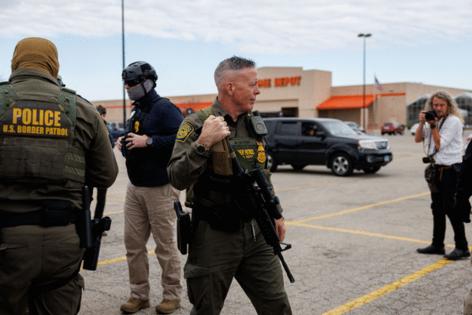Testimony from Bovino, body-cam footage among evidence expected in hearing over use of force by immigration agents
Published in News & Features
CHICAGO — Nearly two months into “Operation Midway Blitz,” the controversial use-of-force tactics by immigration agents under the Trump administration will take center stage Wednesday in a Chicago federal courtroom, where a judge is deciding whether to put more long-term restrictions on the use of tear gas and other chemical agents on crowds and provide enhanced protections for protesters and media.
Among the evidence expected to be presented to U.S. District Judge Sara Ellis during Wednesday’s preliminary injunction hearing: the first sworn testimony from Border Patrol Cmdr. Gregory Bovino and other immigration officials; footage from at least a dozen body-worn cameras agents were wearing during clashes with citizens across the city; and claims made by Bovino and Homeland Security Secretary Kristi Noem that force was appropriate to quell violent “rioters” who were attacking officers.
The hearing is scheduled to begin at 9 a.m. and could last well into the evening, as a temporary restraining order issued by Ellis as part of the underlying lawsuit expires on Thursday and the judge will have to decide quickly on whether to grant the requested remedies.
The case has received national attention, and an overflow courtroom has been set up at the Dirksen U.S. Courthouse to accommodate what is expected to be a large contingent of media and spectators.
The hearing will be lacking at least one element of spectacle: Bovino will not have to appear as a live witness in court, as the plaintiffs agreed to drop that demand in exchange for an additional 90 minutes of deposition time.
But the 30-year Border Patrol veteran will certainly be front-and-center anyways. In arguments before Ellis on Tuesday, plaintiffs’ attorney Steve Art said they intend to show Bovino lied under oath, including making up “a story about getting hit in the head with a rock” in Little Village last month to justify personally lobbing tear gas canisters into the crowd.
The lawsuit filed by the Chicago Headline Club and a consortium of other media groups allege immigration officials have systematically violated the constitutional rights of protesters and reporters during the Trump administration’s ongoing immigration enforcement action, which began in earnest in mid-September and has shown no signs of slowing.
In laying out their case, lawyers for the plaintiffs said in a motion early Tuesday that the evidence in the case shows without injunctive relief, immigration agents “will continue to act as if they can use weapons of war to commit shocking acts of violence against civilians—protesters, press, clergy, bystanders, pregnant women, children—with impunity.”
Lawyers for the government, meanwhile, said that while Department of Homeland Security policy emphasizes respect for human life, de-escalation, and use of safe tactics, agents have a right to use necessary force to protect themselves and enforce lawful orders.
“Rioters have attacked law enforcement personnel with fireworks, rocks, and other objects,” the government filing stated. “Rioters also breached the perimeter of federal buildings, blocked all traffic into the only immigration facility in the region, damaged federal vehicles, and injured officers. At some violent protests, officers responded by issuing dispersal orders and using nonlethal crowd-control devices.”
The Department of Justice also said issuing a preliminary injunction would “continue the judicial micromanaging of immigration enforcement actions” and cause officers to hesitate in the field before protecting themselves or the public “out of fear of contempt.”
Before the hearing begins Wednesday, the parties will be going over a litany of last-minute issues, including whether portions of the proceedings should be sealed from public view.
Department of Justice attorney Elizabeth Hedges argued Tuesday they have not had time to make redactions to officer reports or body cam footage and that the courtroom should be cleared to avoid any inadvertent dissemination of officers’ identifications or non-public Homeland Security tactics or policies.
Art called that argument a “farce.”
“They can’t just seal an American courtroom … based on some vague notion that there is a danger to officers,” Art said.
Ellis asked for a list of everything the Department of Justice thought should be under seal and a brief description on why, and she would rule on the issue ahead of the hearing Wednesday. But she made clear she is not inclined to seal agents’ identifications.
“No other law enforcement officer, unless that officer is operating in an undercover capacity, has his or her identity sealed in a case,” Ellis said. “If a police officer files a report, everybody knows who that police officer is and that is revealed in open court.”
In their motion requesting an injunction, the plaintiffs laid out a series of high-profile incidents over the last month, including clashes between immigration officers in Chicago neighborhoods as well as in the suburbs. The motion accused agents and their supervisors of exaggerating the threat posed by citizens protesting arrests and filming immigration activities and, in many cases, lying about the force used to subdue them.
In one episode from the Lakeview neighborhood on Oct. 24, videos showed that one agent mocked the “vocal but nonviolent crowd of protesters” as tear gas was deployed, saying twice, “have fun!” and laughing at the protesters after the canister went off, according to the plaintiff’s filing.
“The agent then yelled ‘throw another one’ and prepared a second canister,” the filing stated. “Similarly, one agent told another, ‘Hey, throw it (tear gas) for fun.'”
The plaintiffs also alleged that some of the lies have come from Bovino himself, the person identified as the overall leader of “Operation Midway Blitz.”
In his sworn deposition, which lasted 6 1/2 hours over three days, Bovino testified he did not use force against a male protester who was yelling at him outside the Immigration and Customs Enforcement facility in Broadview on Oct. 3, the filing stated. Those assertions had been echoed by ICE Field Director Russell Hott, who claimed in public statements after the incident that Bovino had been assaulted.
But video from the scene showed the man never touched Bovino. Instead, the commander turned toward the man as he was obeying an order to move back and said, “What’d you say?” then climbed over a railing and tackled him to the ground, the filing alleged.
“Bovino’s denial that he applied force against Blackburn and Hott’s echo of this lie undermines the credibility of both witnesses, as well as the government’s broader contentions about rampant violence by protesters,” the plaintiff’s filing stated.
The motion also called into question the government’s claims about a recent incident in Little Village, where Bovino was seen leading an immigration action that targeted a laundromat and discount mall and sparked vehement protests on the streets.
At one point, Bovino was captured on video throwing tear gas above the heads of the crowd without warning and “despite an absence of threats or violence,” the filing alleged.
According to the filing, body-worn camera video turned over as part of the litigation showed Bovino telling his officers, “if you need to deploy gas, you deploy (expletive) gas.” One of the officers allegedly responded, “No, we’re good. We’re good. We’re ready to move out whenever you are,” the filing said.
Instead of the agents moving on, more violence ensued, including one agent who fired a pepper spray ball at close range and threw more tear gas at the crowd, “all without warning,” the filing alleged.
____
©2025 Chicago Tribune. Visit at chicagotribune.com. Distributed by Tribune Content Agency, LLC.







Comments